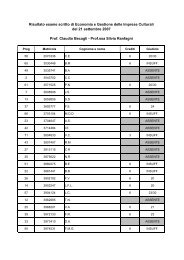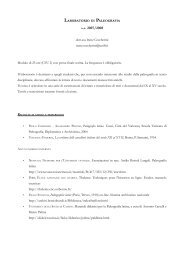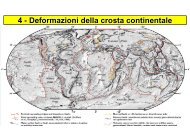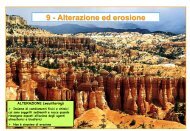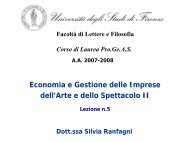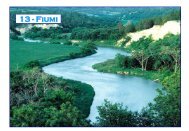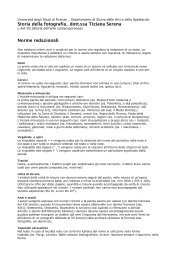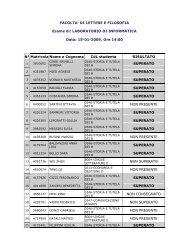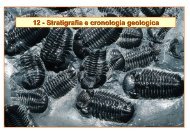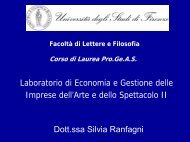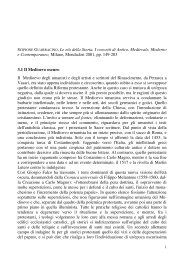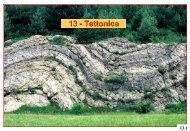Beyond Pragmatics. Morphosyntactic Development in Autism.pdf
Beyond Pragmatics. Morphosyntactic Development in Autism.pdf
Beyond Pragmatics. Morphosyntactic Development in Autism.pdf
Create successful ePaper yourself
Turn your PDF publications into a flip-book with our unique Google optimized e-Paper software.
J <strong>Autism</strong> Dev Disord<br />
Table 6 Relationships among language and other measures for<br />
the ASD group<br />
More generally, given previous f<strong>in</strong>d<strong>in</strong>gs of specific<br />
language subtypes with<strong>in</strong> a large sample of children<br />
with autism (Kjelgaard & Tager-Flusberg, 2001), participants<br />
<strong>in</strong> the autism group were divided <strong>in</strong>to two<br />
language groups, based on PPVT-III scaled scores:<br />
those below 85, n = 5, vs. those above 85, n = 10 (the<br />
one child whose PPVT-III scaled score of 65 was below<br />
70 was excluded from this analysis). For each subgroup,<br />
we subjected the pattern of scores on the IPSyn,<br />
non-verbal IQ, and topic, discourse, and error analyses<br />
to a one-way ANOVA with subgroup as the betweensubjects<br />
variable. F<strong>in</strong>d<strong>in</strong>gs <strong>in</strong>dicated no subgroup differences<br />
(all p’s > .29), with four exceptions: (a)<br />
Nonverbal IQ, F(1,13) = 29.9, p < .001; Borderl<strong>in</strong>e<br />
group, M (SD) = 63.8 (9.0); normal group, M<br />
(SD) = 89.9 (8.6); (b) Jargon production,<br />
F(1,13) = 14.75, p=.002; Borderl<strong>in</strong>e group, M<br />
(SD) = 8.4 (5.3); normal group, M (SD) = 1.9 (1.2); (c)<br />
Un<strong>in</strong>terpretable utterances <strong>in</strong> the discourse,<br />
F(1,13) = 4.8, p < .05; Borderl<strong>in</strong>e group, M<br />
(SD) = .114 (.115); normal group, M (SD) = .027<br />
(.033); (d) Errors of omission and commission (comb<strong>in</strong>ed),<br />
F(1,13) = 4.58, p=.05; Borderl<strong>in</strong>e group, M<br />
(SD) = 1.8 (1.3); normal group, M (SD) = 3.9 (2.0).<br />
Consistent with some previous reports (e.g., Jarrold,<br />
Boucher, & Russell, 1997), these data do not suggest<br />
specific language-impaired and language-typical subgroups<br />
with<strong>in</strong> a relatively small but homogenous group<br />
of children with autism; rather, these data are consistent<br />
with other results <strong>in</strong> <strong>in</strong>dicat<strong>in</strong>g that morphosyntactic<br />
abilities were specifically lower <strong>in</strong> the autism<br />
group.<br />
Discussion<br />
ASD Group<br />
IPSyn – PPVT .475à<br />
IPSyn – Type–Token ratio –.904***<br />
IPSyn – Ignore (Child) –.364<br />
IPSyn – Expand (Child) .398<br />
Jargon – NVIQ –.594*<br />
Jargon – IPSyn –.338<br />
Jargon – PPVT –.554*<br />
Jargon – Type–Token ratio .282<br />
Jargon – Scatter (NP) .577*<br />
Jargon – Ignore (Child) .155<br />
Note: Correlations are reported as r (16)<br />
à p < .10, * p < .05, ** p < .01, *** p < .001<br />
To <strong>in</strong>vestigate morphosyntactic development <strong>in</strong> autism,<br />
5-year-old children with autism and general<br />
developmental delays, and 3-year-old children with<br />
typical development, all matched on non-verbal mental<br />
age, participated <strong>in</strong> a free play session that was transcribed<br />
and analyzed. Receptive vocabulary was<br />
assessed with the PPVT-III.<br />
The most strik<strong>in</strong>g f<strong>in</strong>d<strong>in</strong>g from the present study was<br />
the clear presence of syntactic deficits <strong>in</strong> the autism<br />
group. Controll<strong>in</strong>g for lexical knowledge and nonverbal<br />
IQ, and overall talkativeness, the children with<br />
autism produced language that was significantly less<br />
complex than might be expected for their developmental<br />
level. This result expands upon the 1982 f<strong>in</strong>d<strong>in</strong>g<br />
by Bartolucci and colleagues that children with autism<br />
produced fewer grammatical morphemes than controls.<br />
Even a relatively gross measure of syntactic<br />
ability, MLU, supported the f<strong>in</strong>d<strong>in</strong>g of autism-specific<br />
syntactic delays, show<strong>in</strong>g shorter MLUs <strong>in</strong> the autism<br />
group compared with the DD group, and a trend for a<br />
shorter MLU than the TD group. While the <strong>Autism</strong>/<br />
TD difference was only marg<strong>in</strong>ally significant, post hoc<br />
power analyses <strong>in</strong>dicated that the present f<strong>in</strong>d<strong>in</strong>g may<br />
not have had sufficient power to detect an effect<br />
(1-b = .47), whereas a more sensitive tool such as the<br />
IPSyn was able to demonstrate a group difference.<br />
The results <strong>in</strong>dicated that the autism group likely<br />
reached their syntactic abilities via an atypical developmental<br />
pathway. Individual IPSyn items <strong>in</strong> the<br />
autism group followed a pattern that was marked by<br />
significant <strong>in</strong>ter-item <strong>in</strong>consistency. Although the data<br />
are cross-sectional <strong>in</strong> nature and do not directly<br />
exam<strong>in</strong>e development, they suggest that children <strong>in</strong> the<br />
autism group were not progress<strong>in</strong>g <strong>in</strong> the typical<br />
pathway from simpler forms to <strong>in</strong>creas<strong>in</strong>gly complex<br />
ones.<br />
In contrast to syntactic development, the present<br />
study demonstrated that lexical knowledge was an area<br />
of relative strength for the young children with autism.<br />
In addition to group match<strong>in</strong>g for receptive language,<br />
an analysis of the free play sessions <strong>in</strong>dicated that the<br />
autism group produced as many different word types as<br />
peers, and potentially an even richer set of words<br />
(higher Type-Token ratio) than their mental-agematched<br />
peers without autism. Consistent with previous<br />
studies, the children with autism seemed to<br />
comprehend and produce as many words as their peers.<br />
While some aspects of lexical knowledge <strong>in</strong> autism are<br />
atypical, <strong>in</strong>clud<strong>in</strong>g the use of idiosyncratic mean<strong>in</strong>gs<br />
for words and of neologisms (Rumsey et al., 1985;<br />
Rutter, 1970; Volden & Lord, 1991), adults with autism<br />
often have larger vocabularies than would be predicted<br />
from their other language abilities (Lord & Paul, 1997).<br />
Studies of <strong>in</strong>dividual and developmental differences<br />
<strong>in</strong>dicate that word learn<strong>in</strong>g is highly correlated<br />
123


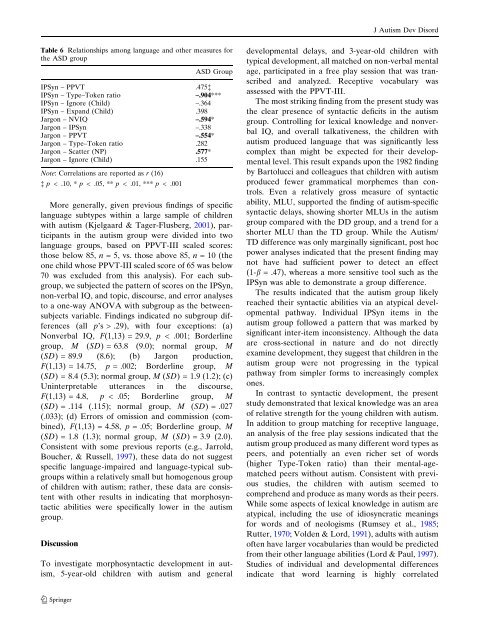
![PATROLOGIA GRECA E LATINA [Patrologiae cursus completus]. All ...](https://img.yumpu.com/50711133/1/184x260/patrologia-greca-e-latina-patrologiae-cursus-completus-all-.jpg?quality=85)
